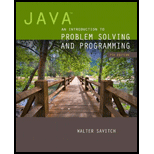
Write the method rotateRight that takes an array of integers and rotates the contents of the array to the right by two slots. Numbers that fall off the right should cycle back to the left. For example, if the input array a {1, 3, 5, 7} then the rotated array should be {5, 7,1, 3}. If the input array a {1, 2, 3} then the rotated array should be {2, 3,1}.
Want to see the full answer?
Check out a sample textbook solution
Chapter 7 Solutions
Java: An Introduction to Problem Solving and Programming (7th Edition)
Additional Engineering Textbook Solutions
Mechanics of Materials (10th Edition)
Electric Circuits. (11th Edition)
Degarmo's Materials And Processes In Manufacturing
Starting Out with Java: From Control Structures through Objects (7th Edition) (What's New in Computer Science)
Management Information Systems: Managing The Digital Firm (16th Edition)
Java How to Program, Early Objects (11th Edition) (Deitel: How to Program)
- What are triggers and how do you invoke them on demand? Give one reference with your answer.arrow_forwardDiscuss with appropriate examples the types of relationships in a database. Give one reference with your answer.arrow_forwardDetermine the velocity error constant (k,) for the system shown. + R(s)- K G(s) where: K=1.6 A(s+B) G(s) = as²+bs C(s) where: A 14, B =3, a =6. and b =10arrow_forward
- • Solve the problem (pls refer to the inserted image)arrow_forwardWrite .php file that saves car booking and displays feedback. There are 2 buttons, which are <Book it> <Select a date>. <Select a date> button gets an input from the user, start date and an end date. Book it button can be pressed only if the start date and ending date are chosen by the user. If successful, it books cars for specific dates, with bookings saved. Booking should be in the .json file which contains all the bookings, and have the following information: Start Date. End Date. User Email. Car ID. If the car is already booked for the selected period, a failure message should be displayed, along with a button to return to the homepage. In the booking.json file, if the Car ID and start date and end date matches, it fails Use AJAX: Save bookings and display feedback without page refresh, using a custom modal (not alert).arrow_forwardWrite .php file with the html that saves car booking and displays feedback. Booking should be in the .json file which contains all the bookings, and have the following information: Start Date. End Date. User Email. Car ID. There are 2 buttons, which are <Book it> <Select a date> Book it button can be pressed only if the start date and ending date are chosen by the user. If successful, book cars for specific dates, with bookings saved. If the car is already booked for the selected period, a failure message should be displayed, along with a button to return to the homepage. Use AJAX: Save bookings and display feedback without page refresh, using a custom modal (not alert). And then add an additional feature that only free dates are selectable (e.g., calendar view).arrow_forward
- • Solve the problem (pls refer to the inserted image) and create line graph.arrow_forwardwho started the world wide webarrow_forwardQuestion No 1: (Topic: Systems for collaboration and social business The information systems function in business) How does Porter's competitive forces model help companies develop competitive strategies using information systems? • List and describe four competitive strategies enabled by information systems that firms can pursue. • Describe how information systems can support each of these competitive strategies and give examples.arrow_forward
- Data communıcatıon digital data is transmitted via analog ASK and PSK are used together to increase the number of bits transmitted a)For m=8,suggest a solution and define signal elements , and then draw signals for the following sent data data = 0 1 0 1 1 0 0 0 1 0 1 1arrow_forwardDatacommunicationData = 1 1 0 0 1 0 0 1 0 1 1 1 1 0 0a) how many bıts can be detected and corrected by this coding why prove?b)what wıll be the decision of the reciever if it recieve the following codewords why?arrow_forwardpattern recognitionPCA algor'thmarrow_forward
 Database System ConceptsComputer ScienceISBN:9780078022159Author:Abraham Silberschatz Professor, Henry F. Korth, S. SudarshanPublisher:McGraw-Hill Education
Database System ConceptsComputer ScienceISBN:9780078022159Author:Abraham Silberschatz Professor, Henry F. Korth, S. SudarshanPublisher:McGraw-Hill Education Starting Out with Python (4th Edition)Computer ScienceISBN:9780134444321Author:Tony GaddisPublisher:PEARSON
Starting Out with Python (4th Edition)Computer ScienceISBN:9780134444321Author:Tony GaddisPublisher:PEARSON Digital Fundamentals (11th Edition)Computer ScienceISBN:9780132737968Author:Thomas L. FloydPublisher:PEARSON
Digital Fundamentals (11th Edition)Computer ScienceISBN:9780132737968Author:Thomas L. FloydPublisher:PEARSON C How to Program (8th Edition)Computer ScienceISBN:9780133976892Author:Paul J. Deitel, Harvey DeitelPublisher:PEARSON
C How to Program (8th Edition)Computer ScienceISBN:9780133976892Author:Paul J. Deitel, Harvey DeitelPublisher:PEARSON Database Systems: Design, Implementation, & Manag...Computer ScienceISBN:9781337627900Author:Carlos Coronel, Steven MorrisPublisher:Cengage Learning
Database Systems: Design, Implementation, & Manag...Computer ScienceISBN:9781337627900Author:Carlos Coronel, Steven MorrisPublisher:Cengage Learning Programmable Logic ControllersComputer ScienceISBN:9780073373843Author:Frank D. PetruzellaPublisher:McGraw-Hill Education
Programmable Logic ControllersComputer ScienceISBN:9780073373843Author:Frank D. PetruzellaPublisher:McGraw-Hill Education





